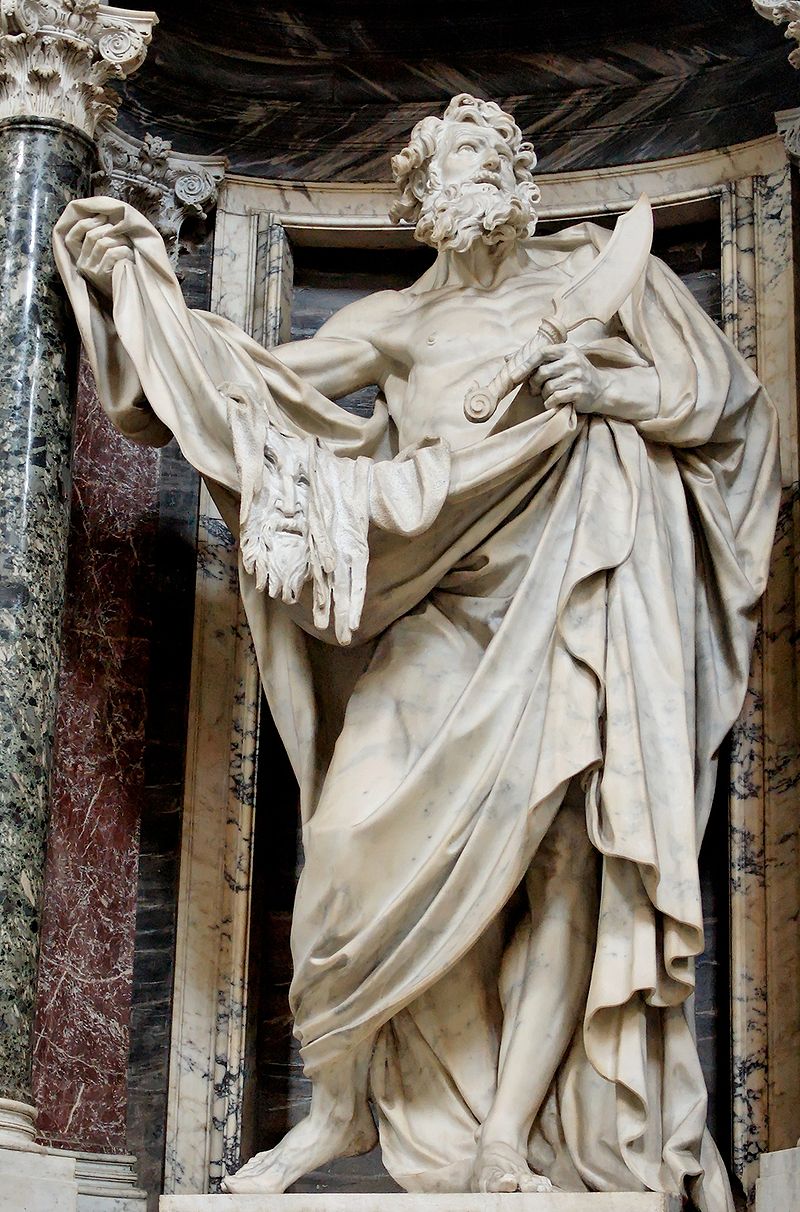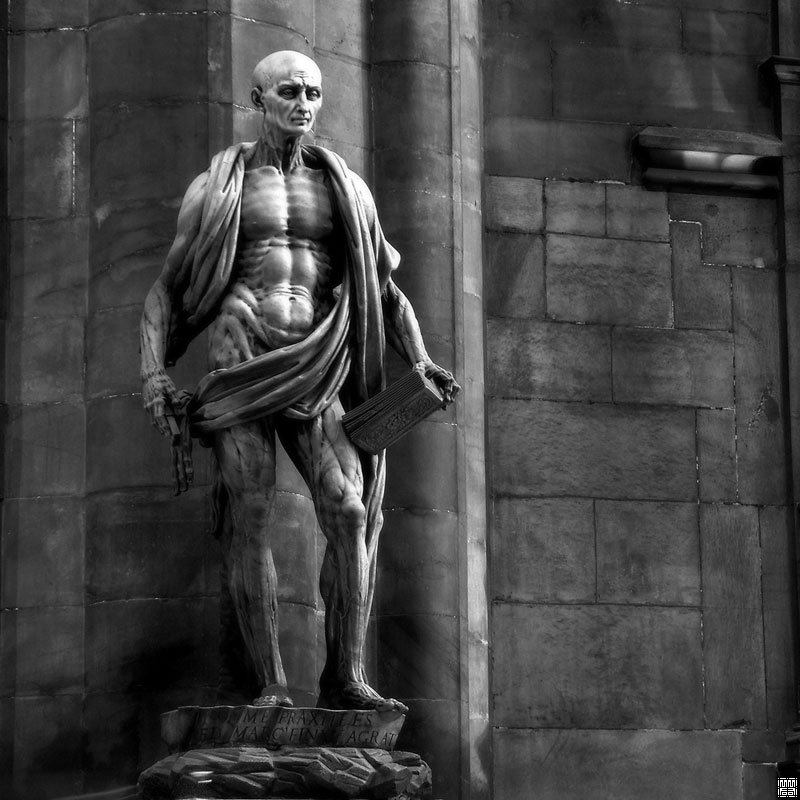|
The next disciple in our series is Bartholomew, who became a disciple at the same time as Philip. Although he is named Bartholomew in the Gospels of Matthew, Mark and Luke, John’s Gospel refers to him as Nathanael. “Philip found Nathanael and told him, ‘We have found the one Moses wrote about in the Law, and about whom the prophets also wrote—Jesus of Nazareth, the son of Joseph.’” (John 1:45) Little is known about Bartholomew/Nathanael, however, at the end of John’s Gospel he is referred to as “Nathanael from Cana in Galilee” (John 21:2) implying he lived fairly locally to Jesus.
It is not certain why Bartholomew has two names, however, the meaning of the names may give us a clue. Bartholomew is an anglicised version of Bar Talmai, which means either “Son of Talmai” or “Son of Furrows”. It is possible that Bartholomew’s father was called Talmai, which was an Aramaic form of the name Ptolemy. Nathanael, on the other hand, means “God has given” but whether he had this name before he met Jesus is unknown and why it was only John’s Gospel that used it is another mystery. When Bartholomew/Nathanael was first called to be a disciple, he was sceptical, asking, “Nazareth! Can anything good come from there?” (John 1:46) Nazareth was not a particularly well-off place at the time and Nathanael could not believe the true Messiah would come from such a place. “When Jesus saw Nathanael approaching, he said of him, ‘Here truly is an Israelite in whom there is no deceit.’” (John 1:47) Nathanael was surprised that Jesus knew him, so Jesus clarified, “I saw you while you were still under the fig tree before Philip called you.” (1:48) From that moment, Nathanael believed Jesus was the Messiah but Jesus tells him, “You believe because I told you I saw you under the fig tree. You will see greater things than that… Very truly I tell you, you will see ‘heaven open, and the angels of God ascending and descending on the Son of Man.” (1:50-51) So, that is how Bartholomew became a disciple, however, nothing else is said of him in the Gospels other than to list him with the other apostles. Bartholomew’s life after the death and resurrection of Jesus has been pieced together by a variety of sources, however, none of them are completely reliable. The Christian historian Eusebius (c.260-340) claims Bartholomew went on a missionary trip to India, where he left a copy of the Gospel of Matthew. Saint Jerome (347-420) agrees with this claim, however, other sources record Bartholomew serving as a missionary in Ethiopia, Mesopotamia, Parthia (Iran), Lycaonia (Asia Minor) and Armenia. Popular legend believes Bartholomew travelled to Armenia with the apostle Jude where they preached about the life of Jesus. It was also in Armenia where he met his death, either from being flayed alive and beheaded or crucified upside down. Bartholomew had reportedly converted Polymius, the king of Armenia, to Christianity, which enraged his brother Prince Astyages. Yet, this does not match historical records of Armenian kings; there was no King Polymius. In India, however, there was an official named Polymius and some scholars state Bartholomew most likely died there in the town of Kalyan. A few texts record the miracles Bartholomew may have performed before and after his death. The two most popular post-death miracles occurred on the Aeolian island, Lipari. On Bartholomew’s feast day (24th August), the people of Lipari were taking part in an annual procession from the Cathedral of St Bartholomew to the main part of the town, carrying a golden statue of the saint. The statue was usually easy to carry, however, on this occasion, it was too heavy and the bearers had to stop and rest a couple of times, delaying the procession. Whilst resting, at the top of a hill, the walls of the town downhill started to collapse. If the people of Lipari had been in the town at the time, they would all have been killed. They believed Saint Bartholomew had saved their lives by making the statue too heavy to carry. The second miracle on Lipari occurred much later during the Second World War. Fascist leaders needed money and ordered a silver statue of Saint Bartholomew to be melted down, however, when it was weighed they discovered it was only a few grams and not worth the effort. The statue was returned to the cathedral but locals knew the statue weighed several kilograms Once again, they believed Saint Bartholomew had altered the weight of the statue. Despite not much being known about Bartholomew, he has been a popular figure in art. In a biography of the disciple by Jacobus de Varagine (1230-1299), Bartholomew’s supposed appearance was described in detail. "His hair is black and crisped, his skin fair, his eyes wide, his nose even and straight, his beard thick and with few grey hairs; he is of medium stature..." Many artists since have used this description when depicting Bartholomew in their paintings. He is also often depicted as being flayed alive. Contemporary artists have also been inspired by Bartholomew’s fate, including Damien Hurst and Gunther Von Hagen, the developer of the exhibition Body Worlds. Due to the legends, Bartholomew was made the patron saint of the Armenian Apostolic Church. He was also celebrated in England, for example, the Bartholomew Fair, which was held in Smithfield, London during the middle ages. St Bartholomew's Street Fair continues to be held annually in Crewkerne, Somerset and is believed to date back to Saxon times. The nature of Bartholomew’s death led him to be made the patron saint of tanners, plasterers, tailors, leatherworkers, bookbinders, farmers, house painters, butchers and glove makers. Just for fun, here are some of the other things and places that have claimed him as their saint:
0 Comments
Your comment will be posted after it is approved.
Leave a Reply. |
©Copyright
We are happy for you to use any material found here, however, please acknowledge the source: www.gantshillurc.co.uk AuthorRev'd Martin Wheadon Archives
June 2024
Categories
All
|


 RSS Feed
RSS Feed